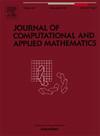克里斯托费尔变换和多重正交多项式
IF 2.6
2区 数学
Q1 MATHEMATICS, APPLIED
Journal of Computational and Applied Mathematics
Pub Date : 2025-10-06
DOI:10.1016/j.cam.2025.117121
引用次数: 0
摘要
我们研究了通过对每个正交测度应用Christoffel变换得到的与测度系统相关的多个正交多项式。本文给出了一种计算变换后的I型和II型多重正交多项式的递推系数和行列式的算法。我们应用这些结果来证明Angelesco或AT系统的多个正交多项式的零与其一步克里斯托费尔变换对应的多项式的零相交。这使我们能够证明经典正交多项式的多重正交类似物所满足的一些交错性质。对于离散多项式,这也产生了对连续零之间最小距离的估计。我们还确定了正交多项式的克里斯托费尔变换与包含有限支持测度的多个正交系统之间的联系。因此,最近邻递推系数的相容关系为一步或多步Christoffel变换的Jacobi系数的计算提供了一种新的算法。本文章由计算机程序翻译,如有差异,请以英文原文为准。
Christoffel transform and multiple orthogonal polynomials
We investigate multiple orthogonal polynomials associated with the system of measures obtained by applying a Christoffel transform to each of the orthogonality measures. We present an algorithm for computing the transformed recurrence coefficients and determinantal formulas for the transformed multiple orthogonal polynomials of type I and type II.
We apply these results to show that zeros of multiple orthogonal polynomials of an Angelesco or an AT system interlace with the zeros of the polynomials corresponding to its one-step Christoffel transform. This allows us to prove a number of interlacing properties satisfied by the multiple orthogonality analogues of classical orthogonal polynomials. For the discrete polynomials, this also produces an estimate on the smallest distance between consecutive zeros.
We also identify a connection between the Christoffel transform of orthogonal polynomials and multiple orthogonality systems containing a finitely supported measure. In consequence, the compatibility relations for the nearest neighbour recurrence coefficients provide a new algorithm for the computation of the Jacobi coefficients of the one-step or multi-step Christoffel transforms.
求助全文
通过发布文献求助,成功后即可免费获取论文全文。
去求助
来源期刊
CiteScore
5.40
自引率
4.20%
发文量
437
审稿时长
3.0 months
期刊介绍:
The Journal of Computational and Applied Mathematics publishes original papers of high scientific value in all areas of computational and applied mathematics. The main interest of the Journal is in papers that describe and analyze new computational techniques for solving scientific or engineering problems. Also the improved analysis, including the effectiveness and applicability, of existing methods and algorithms is of importance. The computational efficiency (e.g. the convergence, stability, accuracy, ...) should be proved and illustrated by nontrivial numerical examples. Papers describing only variants of existing methods, without adding significant new computational properties are not of interest.
The audience consists of: applied mathematicians, numerical analysts, computational scientists and engineers.

 求助内容:
求助内容: 应助结果提醒方式:
应助结果提醒方式:


